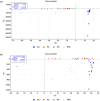Supplementing probiotics during intermittent fasting proves more effective in restoring ileum and colon tissues in aged rats
- PMID: 38445809
- PMCID: PMC10915827
- DOI: 10.1111/jcmm.18203
Supplementing probiotics during intermittent fasting proves more effective in restoring ileum and colon tissues in aged rats
Abstract
This study aimed to explore the impact of SCD Probiotics supplementation on biomolecule profiles and histopathology of ileum and colon tissues during a 30-day intermittent fasting (IF) program. Male Sprague-Dawley rats, aged 24 months, underwent 18-h daily fasting and received 3 mL (1 × 108 CFU) of SCD Probiotics. The differences in biomolecule profiles were determined using FTIR Spectroscopy and two machine learning techniques, Linear Discriminant Analysis (LDA) and Support Vector Machine (SVM), which showed significant differences with high accuracy rates. Spectrochemical bands indicating alterations in lipid, protein and nucleic acid profiles in both tissues. The most notable changes were observed in the group subjected to both IF and SCD Probiotics, particularly in the colon. Both interventions, individually and in combination, decreased protein carbonylation levels. SCD Probiotics exerted a more substantial impact on membrane dynamics than IF alone. Additionally, both IF and SCD Probiotics were found to have protective effects on intestinal structure and stability by reducing mast cell density and levels of TNF-α and NF-κB expression in ileum and colon tissues, thus potentially mitigating age-related intestinal damage and inflammation. Furthermore, our results illustrated that while IF and SCD Probiotics individually instigate unique changes in ileum and colon tissues, their combined application yielded more substantial benefits. This study provides evidence for the synergistic potential of IF and SCD Probiotics in combating age-related intestinal alterations.
Keywords: NF-κB; SCD probiotics; TNF-α; aging; intermittent fasting; intestinal tissue.
© 2024 The Authors. Journal of Cellular and Molecular Medicine published by Foundation for Cellular and Molecular Medicine and John Wiley & Sons Ltd.
Conflict of interest statement
The authors have declared that no competing interests exist.
Figures







Similar articles
-
Exploring the therapeutic potential of plasma from intermittent fasting and untreated rats on aging-induced liver damage.J Cell Mol Med. 2024 Jun;28(12):e18456. doi: 10.1111/jcmm.18456. J Cell Mol Med. 2024. PMID: 38923278 Free PMC article.
-
Reduced liver damage and fibrosis with combined SCD Probiotics and intermittent fasting in aged rat.J Cell Mol Med. 2024 Jan;28(1):e18014. doi: 10.1111/jcmm.18014. Epub 2023 Oct 28. J Cell Mol Med. 2024. PMID: 37897241 Free PMC article.
-
Intermittent fasting-induced biomolecular modifications in rat tissues detected by ATR-FTIR spectroscopy and machine learning algorithms.Anal Biochem. 2022 Oct 1;654:114825. doi: 10.1016/j.ab.2022.114825. Epub 2022 Jul 30. Anal Biochem. 2022. PMID: 35917981
-
Promoting longevity in aged liver through NLRP3 inflammasome inhibition using tauroursodeoxycholic acid (TUDCA) and SCD probiotics.Arch Gerontol Geriatr. 2024 Oct;125:105517. doi: 10.1016/j.archger.2024.105517. Epub 2024 Jun 3. Arch Gerontol Geriatr. 2024. PMID: 38851091
-
The rejuvenating influence of young plasma on aged intestine.J Cell Mol Med. 2023 Sep;27(18):2804-2816. doi: 10.1111/jcmm.17926. Epub 2023 Aug 23. J Cell Mol Med. 2023. PMID: 37610839 Free PMC article.
Cited by
-
Dietary purslane modulates gut microbiota and fecal metabolites in aging rats.Front Microbiol. 2025 Mar 19;16:1549853. doi: 10.3389/fmicb.2025.1549853. eCollection 2025. Front Microbiol. 2025. PMID: 40177479 Free PMC article.
-
Exploring the therapeutic potential of plasma from intermittent fasting and untreated rats on aging-induced liver damage.J Cell Mol Med. 2024 Jun;28(12):e18456. doi: 10.1111/jcmm.18456. J Cell Mol Med. 2024. PMID: 38923278 Free PMC article.
-
Effect of middle-age plasma therapy on ileum morphology, immune defense (IgA) and cell proliferation (Ki-67) of female aged rats.Histochem Cell Biol. 2024 Dec 17;163(1):17. doi: 10.1007/s00418-024-02344-3. Histochem Cell Biol. 2024. PMID: 39688692
-
Trends in intestinal aging: From underlying mechanisms to therapeutic strategies.Acta Pharm Sin B. 2025 Jul;15(7):3372-3403. doi: 10.1016/j.apsb.2025.05.011. Epub 2025 May 22. Acta Pharm Sin B. 2025. PMID: 40698139 Free PMC article. Review.
-
Intermittent Fasting and Probiotics: Synergistic Modulation of Gut Health for Therapeutic Advantages.Probiotics Antimicrob Proteins. 2025 Feb;17(1):479-486. doi: 10.1007/s12602-024-10358-5. Epub 2024 Sep 11. Probiotics Antimicrob Proteins. 2025. PMID: 39261391 Review.
References
-
- Lee JH, Verma N, Thakkar N, Yeung C, Sung HK. Intermittent fasting: physiological implications on outcomes in mice and men. Phys Ther. 2020;35(3):185‐195. - PubMed
-
- de Cabo R, Mattson MP. Effects of intermittent fasting on health, aging, and disease. N Engl J Med. 2019;381(26):2541‐2551. - PubMed
-
- Bagherniya M, Butler AE, Barreto GE, Sahebkar A. The effect of fasting or calorie restriction on autophagy induction: a review of the literature. Ageing Res Rev. 2018;47:183‐197. - PubMed
MeSH terms
LinkOut - more resources
Full Text Sources
Miscellaneous

